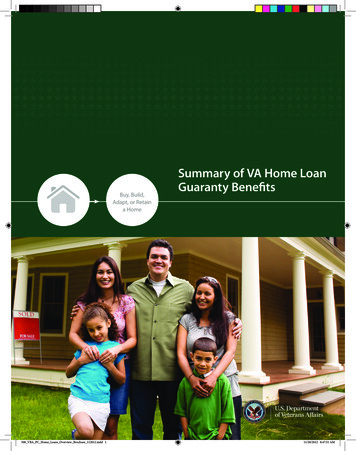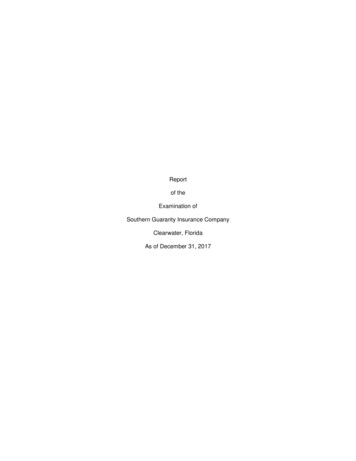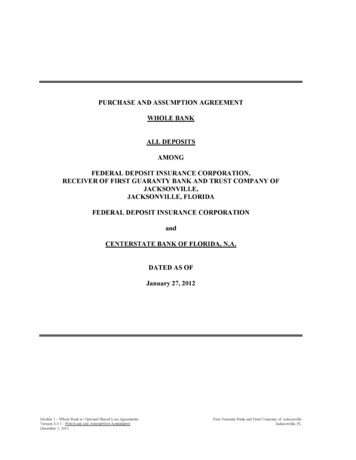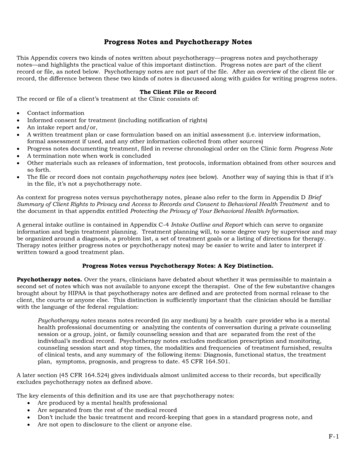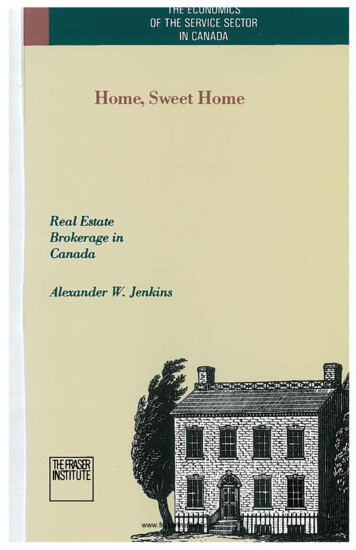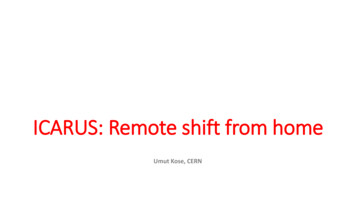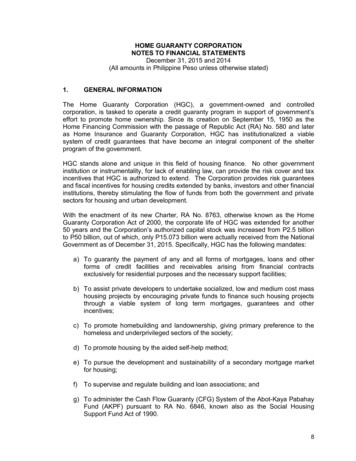
Transcription
HOME GUARANTY CORPORATIONNOTES TO FINANCIAL STATEMENTSDecember 31, 2015 and 2014(All amounts in Philippine Peso unless otherwise stated)1.GENERAL INFORMATIONThe Home Guaranty Corporation (HGC), a government-owned and controlledcorporation, is tasked to operate a credit guaranty program in support of government’seffort to promote home ownership. Since its creation on September 15, 1950 as theHome Financing Commission with the passage of Republic Act (RA) No. 580 and lateras Home Insurance and Guaranty Corporation, HGC has institutionalized a viablesystem of credit guarantees that have become an integral component of the shelterprogram of the government.HGC stands alone and unique in this field of housing finance. No other governmentinstitution or instrumentality, for lack of enabling law, can provide the risk cover and taxincentives that HGC is authorized to extend. The Corporation provides risk guaranteesand fiscal incentives for housing credits extended by banks, investors and other financialinstitutions, thereby stimulating the flow of funds from both the government and privatesectors for housing and urban development.With the enactment of its new Charter, RA No. 8763, otherwise known as the HomeGuaranty Corporation Act of 2000, the corporate life of HGC was extended for another50 years and the Corporation’s authorized capital stock was increased from P2.5 billionto P50 billion, out of which, only P15.073 billion were actually received from the NationalGovernment as of December 31, 2015. Specifically, HGC has the following mandates:a) To guaranty the payment of any and all forms of mortgages, loans and otherforms of credit facilities and receivables arising from financial contractsexclusively for residential purposes and the necessary support facilities;b) To assist private developers to undertake socialized, low and medium cost masshousing projects by encouraging private funds to finance such housing projectsthrough a viable system of long term mortgages, guarantees and otherincentives;c) To promote homebuilding and landownership, giving primary preference to thehomeless and underprivileged sectors of the society;d) To promote housing by the aided self-help method;e) To pursue the development and sustainability of a secondary mortgage marketfor housing;f)To supervise and regulate building and loan associations; andg) To administer the Cash Flow Guaranty (CFG) System of the Abot-Kaya PabahayFund (AKPF) pursuant to RA No. 6846, known also as the Social HousingSupport Fund Act of 1990.8
In carrying out and fulfilling its above stated mandates, the Corporation offers thefollowing guaranty programs:a) Developmental loan guaranty : a guaranty facility covering loans extended for thedevelopment of subdivisions, townhouses, dormitories, apartments and otherresidential dwellings;b) Retail loan guaranty : guaranty coverage on loans/credit facility extended for thepurchase/acquisition of a single-family residence; andc) Guaranty for securitization schemes: guaranty coverage on securities or financialinstruments backed-up by a pool of assets such as receivables fromloans/mortgages and/or real estate properties.The borrowings and guaranty obligations of the Corporation both as to principal andinterest are guaranteed by the Republic of the Philippines subject to the followinglimitations:a) Guaranty obligations, not to exceed 20 times the Corporation’s capital andsurplus; andb) Corporate borrowings, not to exceed the aggregate amount of principalobligations of all accounts guaranteed.With the enactment of its new charter, the HGC is relieved of its peripheral task involvingregistration, supervision and adjudication of Homeowners’ Associations. This functionhas been transferred to the Housing and Land Use Regulatory Board. The Corporationis also vested with a new mandate that will ensure its active involvement in thedevelopment of the secondary market for housing mortgages, bonds, debentures, notesand securities. Further, RA No. 8763 compels the Corporation to give preferentialattention and incentives to socialized and low cost housing.The Corporation is governed by a Board of Directors composed of seven members,including the Chairman as follows:ChairmanVice-chairmanMemberMemberMember: Secretary, Department of Finance: Chairman, Housing and Urban Development CoordinatingCouncil: Director General, National Economic and Development Authority: President, HGC: Three (3) others appointed by the President of the PhilippinesThe policies of the Board are implemented into action by the President with theassistance of the Executive Vice President and five Vice Presidents.In 2009, the Board adopted Board Resolution No. 33-2009 dated July 30, 2009authorizing the President to issue the financial statements of HGC and AKPF – CFGComponent for the calendar year ending December 31, 2008 and every year thereafter.Pursuant thereto, the President of HGC approved the issuance of the financialstatements of HGC for CY 2015 on March 21, 2016.9
The Corporation has its registered office at 335 Jade Building, Sen. Gil J. Puyat Avenue,Makati City.2.SIGNIFICANT ACCOUNTING POLICIESThe principal accounting policies adopted in preparing the financial statements of theCorporation are as follows:2.1.Basis of Financial Statement Preparation(a) Statement of Compliance with Philippine Financial Reporting StandardsThe accompanying financial statements of HGC as of and for the years endedDecember 31, 2015 and 2014 have been prepared by applying accountingpolicies in accordance with the Philippine Financial Reporting Standards (PFRS).PFRS are issued by the Financial Reporting Standards Council (FRSC) andapproved by the Philippine Board of Accountancy (BOA) based on InternationalFinancial Reporting Standards issued by the International Accounting StandardsBoard (IASB).The financial statements have been prepared using the measurement basesspecified by PFRS for each type of asset, liability, income and expense. Themeasurement bases are more fully described in the accounting policies thatfollow.(b) Presentation of Financial StatementsThe financial statements are presented in accordance with Philippine AccountingStandard (PAS) 1, Presentation of Financial Statements. HGC presents all itemsof income and expenses in a single statement of comprehensive income.(c) Functional and Presentation CurrencyThese financial statements are presented in Philippine peso, the Corporation’sfunctional and presentation currency, and all values represent absolute amountsexcept when otherwise indicated.Items included in the financial statements of the Corporation are measured usingits functional currency. Functional currency is the currency of the primaryeconomic environment in which the Corporation operates.2.2.Adoption of New and Amended PFRS2.2.1Effective in 2015 that are Relevant to the CorporationIn 2015, the HGC adopted for the first time the following amendments and annualimprovements to PFRS, which are mandatorily effective for annual periodsbeginning on or after July 1, 2014, for its annual reporting beginning January 1,2015:10
PAS 19 (Amendment):Employee Benefits – Defined BenefitPlans – Employee ContributionsAnnual Improvements:Annual Improvements toPFRS (2010-2012 Cycle) andPFRS (2011-2013 Cycle)Discussed below are the relevant information about these amendment andimprovements:(i)PAS 19 (Amendment), Employee Benefits-Defined Plans–Employee Contributions. The amendment clarifies that if the amount ofthe contributions from employees or third parties is dependent on thenumber of years of service, an entity shall attribute the contributions toperiods of service using the same attribution method (i.e., either using theplan’s contribution formula or a straight-line basis) for the gross benefit.The amendment did not have a significant impact on the Corporation’sfinancial statements.(ii)Annual Improvements to PFRS. Annual improvements to PFRS(2010-2021 Cycle) and PFRS (2011-2013 Cycle) made minoramendments to a number of PFRS. Among those improvements, thefollowing amendments are relevant to the Corporation but had no materialimpact on the Corporation’s financial statements as these amendmentsmere clarify the existing requirements:Annual improvements to PFRS (2010-2012 Cycle) PAS 16 (Amendment), Property, Plant and Equipment, andPAS 38, (Amendment), Intangible Assets. The amendmentsclarify that when an item of property, plant and equipment andintangible assets is revalued, the gross carrying amount isadjusted in a manner that is consistent with a revaluation of thecarrying amount of the asset.Annual Improvements to PFRS (2011-2013 Cycle) PFRS 13 (Amendment), Fair Value Measurement. Theamendment clarifies that the scope of the exception formeasuring the fair value of a group of financial assets andfinancial liabilities on a net basis (the portfolio exception) appliesto all contracts within the scope of and accounted for inaccordance with PAS 39, Financial Instruments: Recognitionand Measurement, or PFRS 9, Financial Instruments, regardlessof whether they meet the definition of financial assets of financialliabilities as defined in PAS 32, Financial Instruments:Presentation.11
PAS 40 (Amendment), Investment Property. Theamendment clarifies the interrelationships of PFRS 3, BusinessCombinations, and PAS 40 in determining the classification ofproperty as an investment property or owner-occupied property,and explicitly requires an entity to use judgment in determiningwhether the acquisition of an investment property is anacquisition of an asset or a group of asset in accordance withPAS 40 or a business combination in accordance with PFRS 3.2.2.2Effective in 2015 that are not Relevant to the CorporationThe following annual improvements to PFRS are mandatory for accountingperiods beginning on or after July 1, 2014 but are not relevant to theCorporation’s financial statements:PFRS (2010-2012 Cycle)PFRS 2 (Amendments)Share-based Payment – Definition ofVesting ConditionPFRS 3 (Amendments)Business Combinations – Accounting forContingent Consideration in a BusinessCombinationPFRS 8 (Amendments)Operating Segments–Aggregation ofOperating Segments, and Reconciliationof the Total of the Reportable Segments’Assets to the Entity’s AssetsPFRS 24 (Amendments)Related Party DisclosuresManagement Personnel–KeyPFRS (2011-2013 Cycle)PFRS 3 (Amendments)2.2.3Business Combinations –Exceptions for Joint VenturesScopeEffective Subsequent to 2015 but not Adopted EarlyThere are new PFRS, amendments and annual improvements to existingstandards effective for annual periods subsequent to 2015 which are adopted bythe FRSC. Management will adopt the following relevant pronouncements inaccordance with their transitional provisions; and, unless otherwise stated, noneof these are expected to have significant impact on the Corporation’s financialstatements:(i)PAS 1 (Amendment), Presentation of Financial StatementsDisclosure Initiative effective from January 1, 2016. The amendmentencourages entities to apply professional judgment in presenting anddisclosing information in the financial statements. Accordingly, it clarifiesthat materiality applies to the whole financial statements and an entity12
shall not reduce the understandability of the financial statements byobscuring material information with immaterial information or byaggregating material items that have different natures or functions.Moreover, the amendment clarifies that an entity’s share of othercomprehensive income of associates and joint ventures accounted forusing equity method should be presented based on whether or not suchother comprehensive income item will subsequently be reclassified toprofit or loss. It further clarifies that in determining the order of presentingthe notes and disclosures, an entity shall consider the understandabilityand comparability of the financial statements.(ii)PAS 16 (Amendment), Property, Plant and Equipment and PAS38 (Amendment), Intangible Assets – Clarification of Acceptable Methodsof Depreciation and Amortization effective from January 1, 2016. Theamendment in PAS 16 clarifies that a depreciation method that is basedon revenue that is generated by an activity that includes the use of anasset is not appropriate for property, plant and equipment. In addition,amendment to PAS 38 introduces a rebuttable presumption that anamortization method that is based on the revenue generated by anactivity that includes the use of an intangible asset is not appropriate,which can only be overcome in limited circumstances where theintangible asset is expressed as a measure of revenue, or when it can bedemonstrated that revenue and the consumption of the economic benefitsof an intangible asset are highly correlated. The amendment alsoprovides guidance that the expected future reductions in the selling priceof an item that was produced using the asset could indicate anexpectation of technological or commercial obsolescence of an asset,which may reflect a reduction of the future economic benefits embodied inthe asset.(iii)PAS 27 (Amendment), Separate Financial Statements – EquityMethod in Separate Financial Statements effective from January 1, 2016.This amendment introduces a third option which permits an entity toaccount for its investments in subsidiaries, joint ventures and associatesunder the equity method in its separate financial statements in addition tothe current options of accounting those investments at cost or inaccordance with PAS 39 or PFRS 9, Financial Instruments. As of the endof the reporting period, the Corporation has no plan to change theaccounting policy for its investments in its subsidiaries and associates.(iv)PFRS 9 (2014), Financial Instruments effective from January 1,2018. This new standard on financial instruments will eventually replacePAS 39 and PFRS 9 (2009, 2010 and 2013 versions). This standardcontains, among others, the following: Three principal classification categories for financial assetsbased on the busin
The Home Guaranty Corporation (HGC), a government-owned and controlled corporation, is tasked to operate a credit guaranty program in support of government’s effort to promote home ownership. Since its creation on September 15, 1950 as the Home Financing Commission with the passage of Republic Act (RA) No. 580 and later
